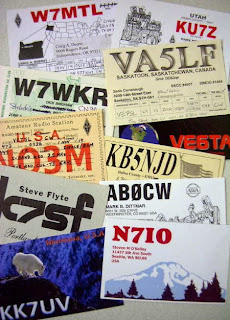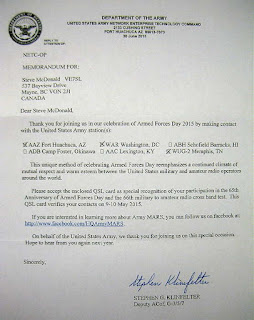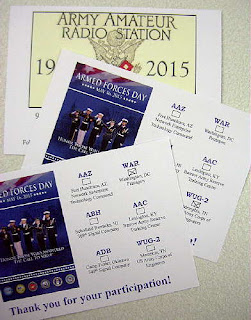Archive for the ‘crossband’ Category
 Another New VE on 630m!
Another New VE on 630m!
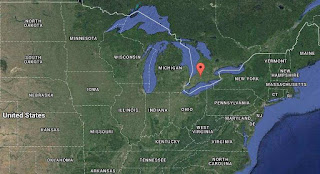 |
| courtesy: https://www.google.ca/maps |
Another new Canadian station has been activated on 630m ... VE3OT, Mitch, in London, Ontario.
For many years, Mitch has been running his QRSS 'MP' beacon on 2200m, using a large E-W wire loop and about 200 watts.
The move to 630m uses the same transmitter with a retuned loop and new output LPF. Although the antenna tuner still needs a capacitor swap and a new toroid to perfectly resonate the loop, Mitch has been getting many good 'audible' reports from eastern stations as well as from the central states and as far south as Texas.
Present testing is in the QRSS6 CW mode on 475.0 kHz. Unfortunately, since moving up to 630m, E-W propagation has been hit and miss and although I can copy his QRSS6 CW signal, I have not had aural copy as of yet ... maybe tonight.
 |
| courtesy: http://www.solarham.net/ |
***************************************************
Another 630m CW crossband activity has been planned for early February and I will have more details shortly. If you missed the last event, here is another chance to get in on the two-way crossband fun ... please stay tuned!
***************************************************
 630 Crossband Excitement
630 Crossband Excitement

In spite of the mediocre band conditions, this past weekend's 630 crossband activity was a great success. Firstly, it was gratifying to see so much activity from the VE7 region. Last year, it was just John, VE7BDQ, and myself, holding the fort, but this year saw new activity from VE7CNF, VA7MM and VE7CA. If this rate keeps up, the band will soon be getting crowded and wouldn't that be great!
It was only a few short months ago that VE7CNF and VA7MM began tinkering on 630m, their signals barely out of the noise here on Mayne Island. How quickly their stations have evolved into systems now capable of working several thousands of miles on the new band. To make the weekend even more special, Markus, VE7CA, had his first-ever 630m contacts on Saturday, working all of the locals and later in the evening, pushing his 14 watts down into Tahuya, WA, working K7CW on crossband. I'll wager that Markus will treasure that first 'DX' QSO for some time.
Conditions from VE7 on Friday were poor, and although somewhat disappointing, not entirely unexpected after watching the sun play tricks on our geomagnetic field all week long. The only path that seemed somewhat normal was the north-south one, yielding contacts with the Californians. As the K-index briefly dropped to '1', Saturday's conditions were much improved, showing short-lived glimpses of normality both to the west and to the east.
On both evenings, the HF bands (and probably 630m to a lesser extent) seemed to be very 'long', with few continental signals being heard. The long skip made it very hard, in some cases, to hear close-in callers on both 40 and 80m ... callers who would normally be 599. Particularly absent where callers from the closer WØ states and the easier W7 regions such as Nevada, Utah and Arizona ... areas that have been easily worked on previous crossband nights. It was also disappointing to not have anyone from the other VE regions call in. I hope it was just conditions and not from lack of trying, as it has been a struggle to generate much interest in the western provinces so far.
The biggest surprise and the highlight of the weekend was most assuredly the crossband contacts between the VE7 stations and Hawaii, with VA7MM, VE7CNF, VE7BDQ and VE7SL, all working Merv, K9FD/KH6 in Maunaloa on Moloka'i Island. Merv noted that all four VE7's were worked within a 25 minute window and all peaked at different times. A few minutes later, the 'tranpacific' path turned 'transcontinental' as NO3M in Pennsylvania, called VE7SL and exchanged 559/549 signal reports ... who would have thought that 630m could generate such magic! This band has so much exciting potential for amateurs, even for those confined to normal suburban backyard locations. Activity will surely skyrocket when U.S. amateurs get access to the band ... hopefully soon.
Several SWL reports were received from the U.S., with one of the most interesting coming on Saturday night, from the maritime operators at KSM, near San Francisco. As well, the Red Oak Victory shipboard station anchored near San Francisco, KYVM, sent a detailed report of several VE7 stations that they had heard.
Crossband Summaries
VE7BDQ :
VA7TA CN79 Courtenay, BC
K6LG DM13 Riverside, CA
VA7MM CN89 Port Coquitlam, BC
VE7KW CN89 Port Coquitlam, BC
K7HV CN87 Seattle, WA
VE7CA CN89 North Vancouver, BC
VE7CNF CN89 Burnaby, BC
VE7SL CN88 Mayne Island, BC
K7CW CN87 Tahuya, WA
VA7JX CN79 Campbell River, BC
VA7DXX CN89 Ladysmith, BC
K9FD/KH6 BL11 Maunaloa, HI
K7SS CN87 Seattle, WA
K6AIG DM04 Mandalay Bay, CA
VE7CNF :
KK7UV DN36 Missoula, MT
VA7MM CN87 Port Coquitlam, BC
K6GZ DM14 Esperia, CA
VA7TA CN79 Courtenay, BC
K6LG DM13 Riverside, CA
K7CW CN87 Tahuya, WA
VE7KW CN89 Port Coquitlam, BC
VE7BDQ CN89 Delta, BC
VA7DXX CN89 Ladysmith, BC
WØYSE CN85 Vancouver, WA
K9FD/KH6 BL11 Maunaloa, HI
VA7MM :
VE7KW CN89 Port Coquitlam, BC
VA7TA CN79 Courtenay, BC
K7CW CN87 Tahuya, WA
K9FD/KH6 BP11 Maunaloa, HI
WØYSE CN85 Vancouver, WA
K7SS CN87 Seattle, WA
VA7DXX CN88 Ladysmith, BC
VE7CA :
VE7SL CN88 Mayne Island, BC
VE7CNF CN89 Burnaby, BC
VE7BDQ CN89 Delta, BC
K7CW CN87 Tahuya, WA
VA7MM CN87 Port Coquitlam, BC
VO1NA :
VE1VDM FN85 Onslow, NS
VO1BQ GN37 St. John's, NL
VE7SL :
VE7KW CN89 Port Coquitlam, BC
KK7UV DN36 Missoula, MT
VA7MM CN87 Port Coquitlam, BC
K6GZ DM14 Esperia, CA
VA7TA CN79 Courtenay, BC
K7CW CN87 Tahuya, WA
K6LG DM13 Riverside, CA
VE7BDQ CN89 Delta, BC
VA7DXX CN88 Ladysmith, BC
VA7JX CN79 Campbell River, BC
K9FD/KH6 BP11 Maunaloa, HI
NO3M EN91 Saegertown, PA
K7SF CN85 Portland, OR
K7SS CN87 Seattle, WA
KGØD/7 CN88 Sequim, WA
W2VJN CN83 Roseburg, OR
It is readily apparent that acres of antenna space are not needed to enjoy 630m ... all of these stations operate out of normal-sized residential lots, with antennas planned and built well enough to exploit the propagation characteristics of 630m.
 | ||
| VA7MM antenna system. More info here. |
| VE7CNF's homebrew PA. Website here. |
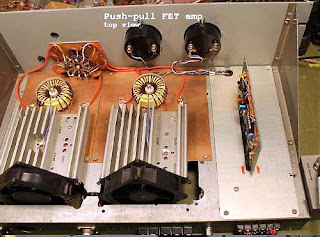 |
| VE7BDQ's homebrew 2200m/630m duo-band tx. |
 630m Crossband – Last Minute Addition
630m Crossband – Last Minute Addition
 Another VE7 has been added to the group of Canadians who will be active tonight and tomorrow night during the CW crossband activity.
Another VE7 has been added to the group of Canadians who will be active tonight and tomorrow night during the CW crossband activity.VE7CA will be operational during the evening on 475.5kHz. He will be listening for calls on both 3555kHz and 7064kHz. His hours of operation will be from 0300Z - 0500Z. This will be Markus's first operation on 630m and he would be delighted to work anybody that is able to hear him. He will be running ~ 25W output to a large top-loaded vertical, high on the hills of North Vancouver.
Please give a listen for him and make all of his hard work worthwhile!
 Upcoming 630m Crossband Weekend
Upcoming 630m Crossband Weekend
 This coming weekend will see the annual '630m activity event' on Friday and Saturday night.
This coming weekend will see the annual '630m activity event' on Friday and Saturday night.There will be a lot of activity from both the U.S. experimental stations and from a group of five Canadian amateurs who will be seeking two-way CW 'crossband' contacts.
The five Canadians will be transmitting on 630m CW but listening for answering stations on various HF (QSX) frequencies. Last year's one-night event was a great success ... hopefuly the two-night event this year will lead to even more participation by interested amateurs in both Canada and the U.S.
Unlike Canadian hams, American amateurs does not yet have access to 630m as a ham band but ... there will be a large number of U.S. 'experimental' stations (most of them operated by hams with an experimental licence) beaconing and working each other and seeking your 'heard' reports. The Canadian operation will give interested hams the actual opportunity to make a two-way MF to HF CW contact, via the crossband mode as well as provide the Canadians an opportunity to test their 630m systems.
Here are the details of the five Canadian crossbanders:
Station: VO1NA (Joe) GN37 Torbay, Newfoundland
Time: 2130Z - 0130Z both Friday night (Nov 13-14Z) / Saturday night (Nov
14-15Z)
TX Frequency: 477.7 kHz
RX (QSX) Frequency: 3562 kHz
Station: VE7SL (Steve) CN88 Mayne Island, B.C.
Time: 0200Z - 0700Z both Friday night (Nov 14Z) / Saturday night (Nov 15Z)
TX Frequency: 473.0 kHz
RX (QSX) Frequency: 3566 / 7066 kHz
Station: VE7BDQ (John) CN89 Delta, B.C.
Time: 0430Z - 0700Z both Friday night (Nov 14Z) / Saturday night (Nov 15Z)
TX Frequency: 474.0 kHz
RX (QSX) Frequency: 3536 kHz
Station: VA7MM (Mark) CN89 Coquitlam, B.C.
Time: 0500Z - 0700Z Friday (Nov 14Z)
0400Z - 0800Z Saturday (Nov 15Z)
TX Frequency: 475.0 kHz
RX (QSX) Frequency: 3570 kHz
Station: VE7CNF (Toby) CN89 Burnaby, B.C.
Time: 0300Z - 0700Z both Friday night (Nov 14Z) / Saturday night (Nov 15Z)
TX Frequency: 476.0 kHz
RX (QSX) Frequency: 3558 kHz / 7062 kHz
All stations will either call CQ or run "VVV" marker beacons while listening on their respective QSX frequencies. QSX frequencies will be included
in the CQ or marker beacons.
Last year's event saw many nice contacts, some of them from coast-to-coast! I really hope that as many amateurs as possible will have a listen and be able to answer our 'CQ's on the various QSX frequencies. Your participation on one (or both) of the two night's activity would be just great.
I will post a reminder of the event again at the end of the week ... in the meantime, try to see what you can hear on 630m (472-479kHz) and arrange your setup so that you can call us on HF as well.
For a more detailed description of the upcoming event, see the ARRL's announcement here.
 630m Crossband Schedule
630m Crossband Schedule
 |
| VO1NA Torbay, Newfoundland |
There are now five Canadian amateurs slated to operate over the course of the two-night event (Friday & Saturday) and they will be looking for two-way crossband contacts with amateurs in the U.S. and Canada. Here is the schedule of frequencies and times:
Station: VO1NA (Joe) GN37 Torbay, Newfoundland
Time: 2130Z - 0130Z both Friday night (Nov 13-14Z) / Saturday night (Nov 14-15Z)
TX Frequency: 477.7 kHz
RX (QSX) Frequency: 3562 kHz
Station: VE7SL (Steve) CN88 Mayne Island, B.C.
Time: 0200Z - 0700Z both Friday night (Nov 14Z) / Saturday night (Nov 15Z)
TX Frequency: 473.0 kHz
RX (QSX) Frequency: 3566 / 7066 kHz
Station: VE7BDQ (John) CN89 Delta, B.C.
Time: 0430Z - 0700Z both Friday night (Nov 14Z) / Saturday night (Nov 15Z)
TX Frequency: 474.0 kHz
RX (QSX) Frequency: 3536 kHz
Station: VA7MM (Mark) CN89 Coquitlam, B.C.
Time: 0500Z - 0700Z Friday (Nov 14Z)
0400Z - 0800Z Saturday (Nov 15Z)
TX Frequency: 475.0 kHz
RX (QSX) Frequency: 3570 kHz
Station: VE7CNF (Toby) CN89 Burnaby, B.C.
Time: 0300Z - 0700Z both Friday night (Nov 14Z) / Saturday night (Nov 15Z)
TX Frequency: 476.0 kHz
RX (QSX) Frequency: 3558 kHz / 7062 kHz
These stations will be calling CQ on CW at regular intervals throughout the evening, and listening for answers on the allocated HF call-back (QSX) frequency. The sequence that I will be using (and others in a similar fashion) is:
"CQ CQ CQ de VE7SL VE7SL VE7SL QSX 3566 and 7066kHz K". After listening for callers on either QSX frequency for approximately 30 seconds, the CQ will be repeated if no callers are heard.
With good conditions, propagation can often span the continent, so please consider taking part in the activity from wherever you might be located in North America. Last year, crossband contacts were made between here and W3 / W5 and many points in between.
For eastern stations, VO1NA, in Newfoundland, should be a tantalizing target with coverage throughout the eastern states while the four VE7 stations should prove workable for central and western North American amateurs.
Those that might wonder about the 'legality' of crossband contacts need not worry. Canadian amateurs have had legal access to 630m for almost two years now and crossband contacts with any stations in the amateur radio service are the same as a two-way QSO on any other band. Unfortunately, amateurs are not allowed to contact any of the experimentally-licenced stations ... they are permitted to work each other only.
Hopefully you will print out the operating schedule and consider participating in the November crossband activity weekend ... the more the merrier! It would be great to see even more contacts than last year, which was a great start, considering the less than optimum conditions. I will post more details as the event weekend draws closer. We hope to see you there!
 Another 630m Crossband Weekend
Another 630m Crossband Weekend
 Fritz Raab (W1FR), the ARRL's 600m Experiment Coordinator, has indicated that this year's '630m Special Operating Event' will be held on the weekend of November 13 / 14. Mark your calendars if you plan to participate as it looks as though, once again, along with the numerous U.S. experimental stations beaconing and coastal maritime stations, several Canadian 630m stations will be active and looking for realtime CW 'crossband' contacts! Canadian stations will 'CQ' on specific frequencies and will listen for calling stations on designated HF (80/40m) answering (QRSS) frequencies.
Fritz Raab (W1FR), the ARRL's 600m Experiment Coordinator, has indicated that this year's '630m Special Operating Event' will be held on the weekend of November 13 / 14. Mark your calendars if you plan to participate as it looks as though, once again, along with the numerous U.S. experimental stations beaconing and coastal maritime stations, several Canadian 630m stations will be active and looking for realtime CW 'crossband' contacts! Canadian stations will 'CQ' on specific frequencies and will listen for calling stations on designated HF (80/40m) answering (QRSS) frequencies.Unlike last year, the Canadian stations will be operating for several hours on both nights, since there will be no conflict with the ARRL's CW Sweepstakes Contest as in 2014. Please stay tuned as there will be further details to follow regarding specific stations, frequencies and times ... notifications will be published on both the ARRL and RAC web 'news' pages as well as on numerous ham radio reflectors.
There's still lots of time to tweak up your 630m receiving capabilities ... it should be an interesting weekend, especially if the mid-November propagation cooperates.
A summary of last year's Friday night crossband activity can be found here.
 Army-Navy Crossband
Army-Navy Crossband
Yesterday's mail brought an official - looking envelope from the U.S. Army! It contained a very nice letter from Fort Huachuca, Arizona, thanking me for participating in the '66th Military-Amateur Crossband Test' as well as three QSL's for the Army-affiliated contacts that I had made back in May.
During the activity, I was able to work Army stations AAZ (AZ), WAR (Pentagon), WUG-2 (TN) ... all on 20m via the crossband mode as the military stations transmitted outside of the band.
In addition to these three, two Navy stations were worked ... NWVC (IN) and NPD (TN) but it appears that 'Army' has beaten 'Navy' ... at least when it comes to QSL'ing!

